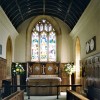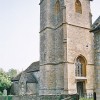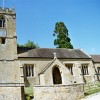The hundreds of Sexpena and Hanlega were amalgamated probably in the 14th century and became the Hundred of Sixpenne et Henle. The parish was formed in the 19th century when two chapelries, Handley and Gussage St. Andrew, previously parts of the parish of Iwerne Minster, were united. However, Handley had been a parish until the 13th century.
Until relatively recent times the village was known simply as Handley. It lies in the eastern part of the parish, comprises over six thousand acres and spans the upper reaches of three valleys in the north-east of the county. This is the largest village in Cranborne Chase and it is the economic heart of the parish. In the west of the parish are the early settlements of Minchington and Gussage St. Andrews, where two later settlements appear to have sprung up: Woodcutts, in existence by 1244 and Dean, in existence since 1278.
The Parish Church of St. Mary is at the north-west end of the village. There are pointers to a 12th century building: a stone carved image of Christ-in-Majesty; the font and a capitol re-used as a stoup in the porch, but nothing else from that period has survived. The chancel and the south porch date from the 14th century and a north aisle was added in 1832. In 1877 the 14th century porch was taken down and re-erected in its present position and a south aisle was built on. At the same time the nave, north aisle and west tower were rebuilt. Amongst the monuments in the church is one to John Alie, who died in 1579, and his family; there is a brass commemorating the life of James Isaac, the parish clerk whose family held that position for a 128 years including throughout the 19th century.
Isaac Gulliver, the notorious smuggler, used Handley as one of his bases and it was at St. Mary’s Church that he married Betty Beale on the 5th of October 1768. A newspaper in 1770 reported that a posse of the Excise men came to the village and seized contraband tea and brandy hidden in a cottage in the village; they had to beat off an attack from local free traders and managed to get the contraband safely back to the Excise Superintendents house in Blandford. Later in the evening about 150 men armed and on horseback came to Blandford and persuaded the Excise officer’s wife at gun-point to give them back the contraband. (See our story: Isaac Gulliver – Dorset’s Smuggler King, published 24th April 2010 in the Real Lives category.)
The village sits in a part of the county where there are many prehistoric remains. Local land owner General Pitt-Rivers was responsible for much archaeological work in the area, notably at Wor Barrow, a Neolithic long barrow about a mile to the east of the village and at a site on the common near to the hamlet of Woodcutts. More recently Bournemouth University has carried out a considerable amount of work hereabouts. (See our story: General Pitt-Rivers & the Cranborne Years, in the Biography category, published 19th November 2012.)
A fire in 1892 destroyed most of the village; inevitably most of the buildings along the long High Street are modern and include several shop premises. Within the parish boundaries however, there are several examples of attractive houses dating back to the 16th, 17th and 18th centuries. This is not a picture post card village but whether or not it still deserves Frederick Treves accolade of “..the ugliest village in Dorset,” is something you will have to make your own mind up about.
(See our story Sixpenny Handley – the Fire of 1892, published 2nd December 2012 in the Sixpenny Handley category.)



